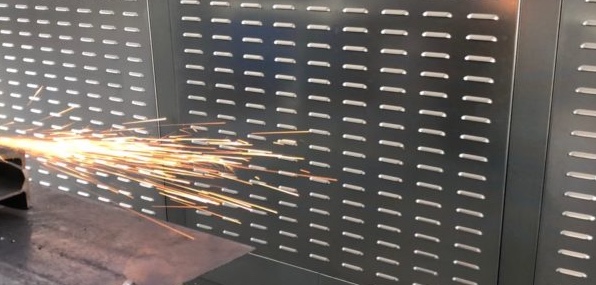
Often in professional contexts, the risk of grinding dust is taken a little “lightly” compared to other pollutants because it generates less smoke and for this reason, it is less “visible” to an inexperienced eye.
However, those who attend mechanical workshops are perfectly able to “feel” the typical smell of metal released and “see” the layer of fine dust produced.
In fact, grinding exposes the operator and the surrounding environment to inhalable and respirable powders potentially very dangerous for health because of low grain size.
Furthermore, the grinding powders dispersed in the environment can also damage sensitive and electronic machinery in your production plant.

Inside the industrial production process, especially in the mechanical sector, the metal grinder is the operator that uses specific tools and related abrasives with the aim of smoothing or polishing metal surfaces.
In fact, the grinding activity consists of the removal of material with the use of the grinding wheel to obtain surfaces of high finish, dimensional accuracy, and shape.
Risks and damage to people and equipment
Often in professional contexts, the risk of grinding dust is taken a little “lightly” compared to other pollutants because it generates less smoke and for this reason, it is less “visible” to an inexperienced eye.
However, those who attend mechanical workshops are perfectly able to “feel” the typical smell of metal released and “see” the layer of fine dust produced.
In fact, grinding exposes the operator and the surrounding environment to inhalable and respirable powders potentially very dangerous for health because of low grain size. Furthermore, the grinding powders dispersed in the environment can also damage sensitive and electronic machinery in your production plant.
Effective suction directly at the source
All these problems can be solved with the right suction and filtration systems. Grinding powders can often disperse and settle easily in every corner of the work area; there are many methods to manage this risk, but the most effective is their “capture” directly at the source.
Aspirating the dust before it reaches the worker’s breathing area prevents the worker from being exposed to it and helps prevent contamination of expensive sensitive electronic machinery and equipment that may be present in the work area. Most grinding and surface treatments should generally have effective extraction at the source and only when this is not possible should more complex systems for air purification in the environment be considered, such as suction benches or a centralized suction system in case there are many workstations to be served.
Once the suction system is selected, remember that it will work effectively only if:
Know the application and evaluate your security needs
Your equipment for collecting fumes, the type of filtration, and the complementary personal protection depend on the type of material you are working on and on multiple working situations, variable depending on the production layout.
Always evaluate your work situation critically with the safety officer, asking:
The answers to the above questions will take you in the right direction: this means improving the working environment by minimizing the risks for all people involved and helping you to select the most suitable grinding dust extraction and filtration system for your environment.
Here are some typical technical solutions. Please contact us to get a quote or advice on the right one for your business.
Sources:
– Inail – Profili di rischio nei comparti produttivi dell’artigianato, delle piccole e medie imprese e pubblici esercizi: Industrie Meccaniche
– Wikipedia, processo di produzione industriale
Fill in the form below to request a quote by email, agree on special conditions, or technical clarifications